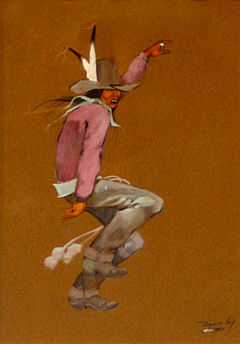Jerome Tiger

Jerome Richard Tiger (1941–1967) was a highly influential Native American painter from Oklahoma.[1] Tiger produced hundreds of paintings from 1962 until his death in 1967.[1][2]
A fullblood Muscogee Creek-Seminole, Tiger's style is said to be a combination of "spiritual vision, humane understanding, and technical virtuosity" but with traditional subject matter and composition.[1]
His paintings first gained recognition at the Philbrook Museum of Art.[2]
Early life
Born in Tahlequah, Oklahoma on July 8, 1941, Tiger attended public schools in Eufaula, Oklahoma and Muskogee, Oklahoma.[2] English was not his first language.[1]
Dropping out of high school at the age of 16, Tiger joined the United States Navy and served in the Naval Reserve from 1958 to 1960.[2] He also worked as a laborer and prize fighter.[1] He studied at the Cleveland Engineering Institute in Cleveland, Ohio, but dropped out after one year.[2]
Artistic career
In 1962, a friend encouraged Tiger to submit his paintings to the American Indian Artists Annual at the Philbrook Museum of Art in Tulsa, Oklahoma.[2] He began to produce a prolific number of paintings over the next several years,[1] winning numerous awards.[2] In 1966, the Philbrook Museum of Art displayed a solo exhibit of Tiger's art.[2] During this time, he lived in Muskogee, Oklahoma.[3]
Tiger was compared to Rembrandt and Francisco Goya because of his ability to draw an object or person after a short glance.[1] He worked in oil, watercolor, tempera, casein, pencil, and pen and ink.[3]
Death and legacy
Tiger died from a handgun accident on August 13, 1967, at the age of 26.[2] His art can be found at the Philbrook and Gilcrease Museums in Tulsa, Oklahoma, the OSU Museum of Art in Stillwater, Oklahoma, the Five Civilized Tribes Museum in Muskogee, Oklahoma, the Woolaroc Museum near Bartlesville, Oklahoma, the Museum of New Mexico in Santa Fe, New Mexico, the Museum of the American Indian and the Bureau of Indian Affairs.[2]
Jerome's brother Johnny Tiger, Jr. and daughter Dana Tiger[4] are successful artists. His son Chris, who was a budding artist, was killed in 1990.[5] Jerome's other daughter, Lisa Tiger, is a prominent AIDS educator and activist as well as a motivational speaker.[6]
See also
- Bacone school
- Muscogee (Creek) Nation
- List of Native American artists from Oklahoma
- Seminole Tribe of Oklahoma
References
- ↑ 1.0 1.1 1.2 1.3 1.4 1.5 1.6 Jerome Tiger (1941-1967), Mid-America All Indian Center (accessed May 25, 2010).
- ↑ 2.0 2.1 2.2 2.3 2.4 2.5 2.6 2.7 2.8 2.9 Hunt, Dave C., 'Tiger, Jerome Richard (1941-1967)," Encyclopedia of Oklahoma History and Culture (accessed May 25, 2010).
- ↑ 3.0 3.1 Tiger, Jerome Richard, Native Arts of America (accessed May 25, 2010).
- ↑ "Dana Tiger–Creek Tribe." Native American Art Exhibit. (retrieved 26 May 2010)
- ↑ "Jerome Christopher Coleman "Chris" Tiger". Find A Grave. Find A Grave. Retrieved 8 April 2015.
- ↑ Lisa Tiger HIV/AIDS Educator (retrieved 26 May 2010)
Further reading
- Tiger, Peggy and Molly Babcock. The Life and Art of Jerome Tiger: From War to Peace, Death to Life. Norman: University of Oklahoma, 1980. ISBN 0-8061-1656-0.
External links
- Jerome Tiger (1941 - 1967), Mid-America All Indian Center
- Encyclopedia of Oklahoma History and Culture - Jerome Richard Tiger
|